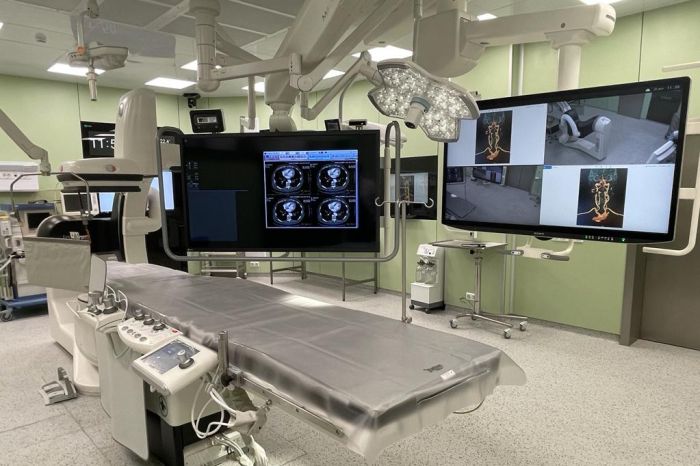
Closed loop
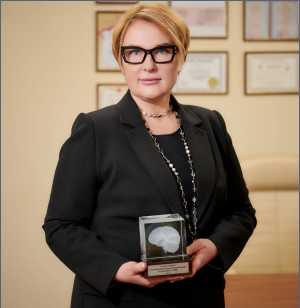
— Tell us about the history of the Regional Vascular Center.
— Lyudmila Roshkovskaya: The Regional Vascular Center at the Alexander Hospital opened in December 2022. This is a joint project of the chief physician Yuri Lintz, the Health Committee and the Administration of St. Petersburg.
The main task of the center is to provide round-the-clock emergency care to patients with acute cerebral circulatory disorders (stroke), acute coronary syndromes (unstable angina and myocardial infarction) and other cardiovascular diseases.
In a short time, the vascular center has become not only the most technologically advanced and largest in the region, but also, by decision of the Ministry of Health of Russia, it was recognized as the best among 869 vascular centers in the country in 2023.
— What is the RVC, and what is the specifics of its activities?
— L. R.: For the first time in the North-West, it was possible to create a vascular center, which was designed and built taking into account all the logistics requirements for providing medical care to vascular patients. Here, all the requirements of the procedures for providing medical care to patients with heart attack and stroke are met, the time from the moment of admission to the start of high-tech treatment methods is minimized, a complete closed cycle of medical care for this category of patients is formed.
The new building has its own reception department, all the necessary diagnostic services, including CT, MRI, ultrasound and X-ray diagnostics, a laboratory diagnostic complex, as well as three modern operating rooms, two intensive care units. The total capacity is 274 beds (231 for specialized medical care and 42 intensive care beds).
Two stationary and one mobile angiographic units are located in the operating unit to ensure the smooth operation of the X-ray surgical diagnostic and treatment methods service.
For vascular patients, the rule of the “golden hour” applies, when the earlier medical care is provided, the less disability and better treatment outcomes.
In the new building, everything has been thought out to the smallest detail to reduce the time from the “door to the needle”: a warm heated garage to reduce the temperature difference, from which patients immediately enter the critical condition unit; all diagnostic equipment is placed in the waiting room on the principle of “technique to the patient”, high-speed elevators for delivering patients to the operating room, duplication equipment in order to avoid waiting for medical care when several patients are admitted. The building offers a full range of rehabilitation equipment for the earliest possible start of rehabilitation treatment, speech therapists, psychologists, physical therapy instructors, physiotherapists, occupational therapists work.
For the first time, the Regional Vascular Center included not only neurological and cardiological departments, but also a neurosurgical department, a department of vascular surgery, which made it possible to increase the availability of surgical care to patients.
The basis for the possibilities
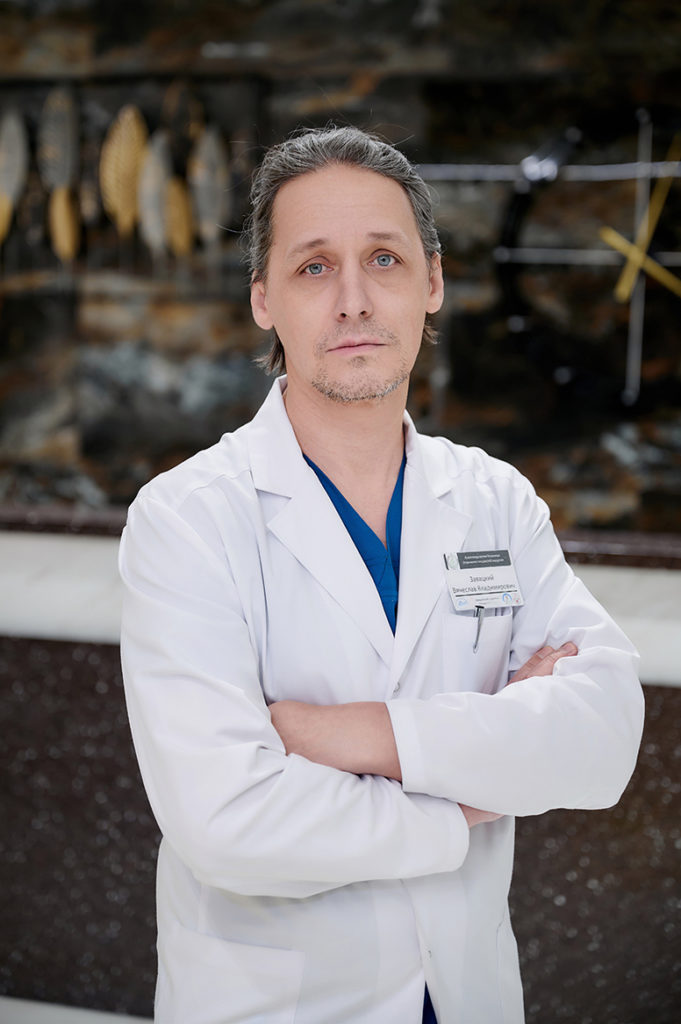
— What was the reason for the inclusion of the vascular surgery department in the RVC?
— Vyacheslav Zavatsky: Patients admitted, for example, with a stroke, may often need the help of a vascular surgeon, namely, performing an open thrombendarterectomy (removal of a blood clot or atherosclerotic plaque from an artery localized in the neck). Narrowing of the lumen of the main vessel before entering the skull often causes a stroke. Also, in cases of tandem (combined) lesions of the arteries of the neck and head, the presence of a vascular surgeon in the RVC makes it possible to conduct simultaneous surgery, when one part is performed openly by vascular surgeons, and the other part is endovascular by specialists of X–ray endovascular treatment methods.
Since vascular surgeons are not supposed to be present in conventional RVCs, it is technically impossible to provide assistance to these patients. There are city hospitals with vascular surgery departments, but there are few of them and, most importantly, they are not included in the teamwork within the RVC.
The situation is also with hemorrhagic strokes, which occur against the background of an aneurysm rupture, arteriovenous malformation, in the treatment of which neurosurgeons and/ or X–ray endovascular surgeons are necessarily involved – cranial trepanation, aneurysm clipping, embolization, removal of intracranial hematomas or other types of interventions. Accordingly, such a multidisciplinary set of specialists in the RVC maximizes the quality and accessibility of specialized medical care for vascular patients, which, in fact, was done for the first time in St. Petersburg on the basis of the Alexander Hospital. Our RVC was originally designed and built with these directions in mind.
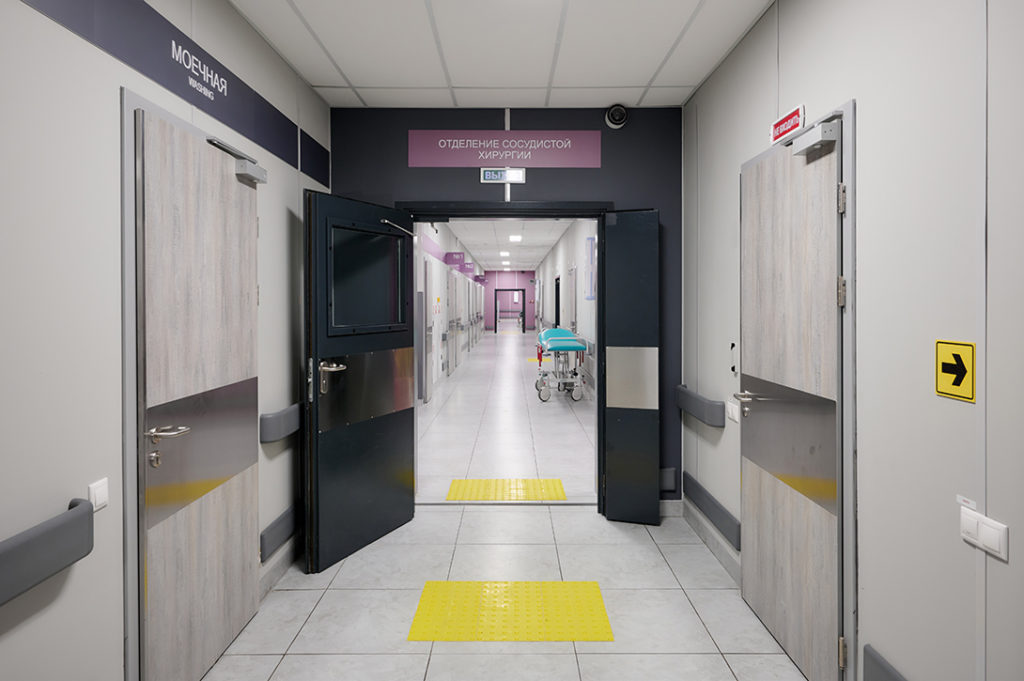
— But doesn’t the legislation provide for vascular surgery departments as part of the RVC?
— V. Z.: According to Law No. 323-FZ “On the basics of protecting the health of citizens in the Russian Federation” and other regulatory documents, including the procedures for providing medical care to patients with cardiovascular diseases, all medical care is regulated. The organizational and staff structure, the list of departments and equipment, the order of work, etc. are prescribed.
Unfortunately, the Department of Vascular Surgery is not mentioned in the Order of the Ministry of Health No. 918n “On approval of the Procedure for providing medical care to patients with cardiovascular diseases”. The procedures include departments of cardiac surgery, departments of cardiac arrhythmia, departments of X–ray endovascular surgery and others – that is, everything except departments of vascular surgery.
We (the Russian Society of Angiologists and Vascular Surgeons) have been working for many years to ensure that the department of vascular Surgery is included in this order regulating our work.
On the one hand, this is bad, but on the other hand, it is good, because the chief physician who cares for patients, the city managment, taking advantage of this legislative “failure”, can create departments taking into account modern requirements, and not according to the often outdated standard of equipment. So, for example, we opened a vascular surgery department with a hybrid operating room, which was equipped with state-of-the-art equipment. As of today, there are no more such operating rooms in the city.
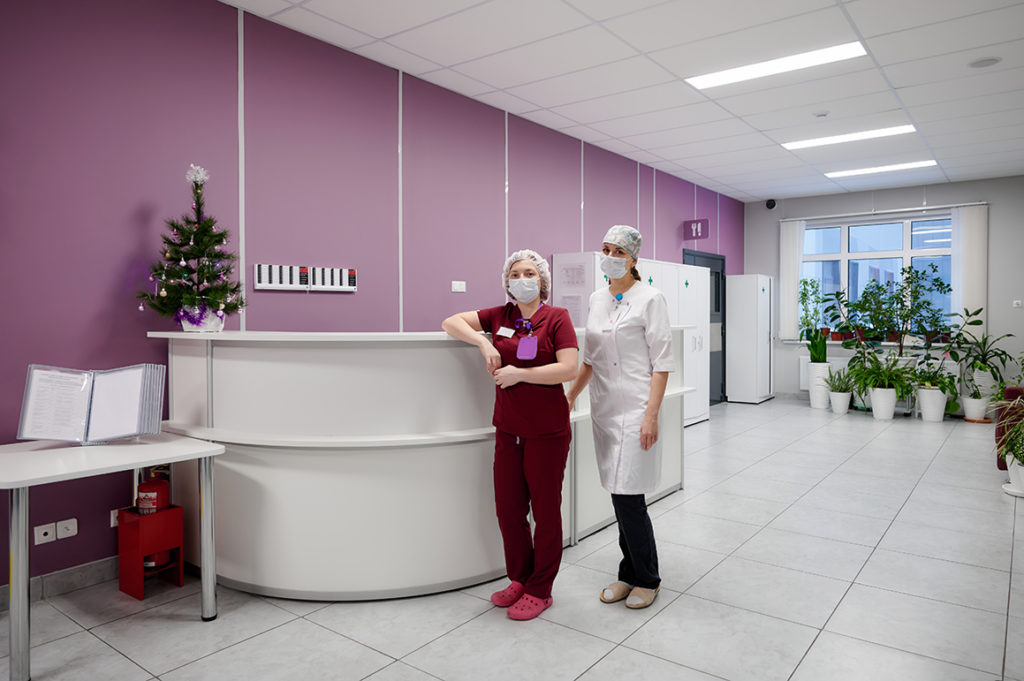
Do it all at once
— Tell us more about this operating room of the vascular surgery department.
— V. Z.: The vascular department includes a hybrid vascular operating room. This is a special pride. Such an operating room is at least the only one in St. Petersburg. It consists of two tables – for “open” and “closed” intravascular interventions, a modern endovascular installation, an ultramodern lighting system with an integrated video camera, a medical imaging system: in the area of operating tables, Sony 55″ medical monitors as 4K — on them we display the images we need during surgery (ultrasound, X-ray, etc.).
There are also specialized MVS monitors built into the wall in the operating room and in the corridor of the operating unit. Invited specialists, residents, and students can observe the course of the operation on them, without interfering with surgeons.
The control of equipment and engineering systems — light, temperature, humidity in the operating room is carried out using MVS control panels — according to the principle of a smart home for a surgeon with the possibility of video recording of operations.
Also in the operating room there is a modern portable ultrasound scanner integrated into the MVS complex, thanks to which — and this is important for us — we can display the ultrasound image from the small screen of the device to any large screen of the MVS complex convenient for the operator. It is necessary to work on the aorta, arteries and veins. We also have a Cell Saver device for intraoperative blood reinfusion (cellular restoration of blood lost during surgery) and a modern electrosurgical device with intelligent touch panel technology, modern suction systems, a complex of modern anesthesiological equipment.
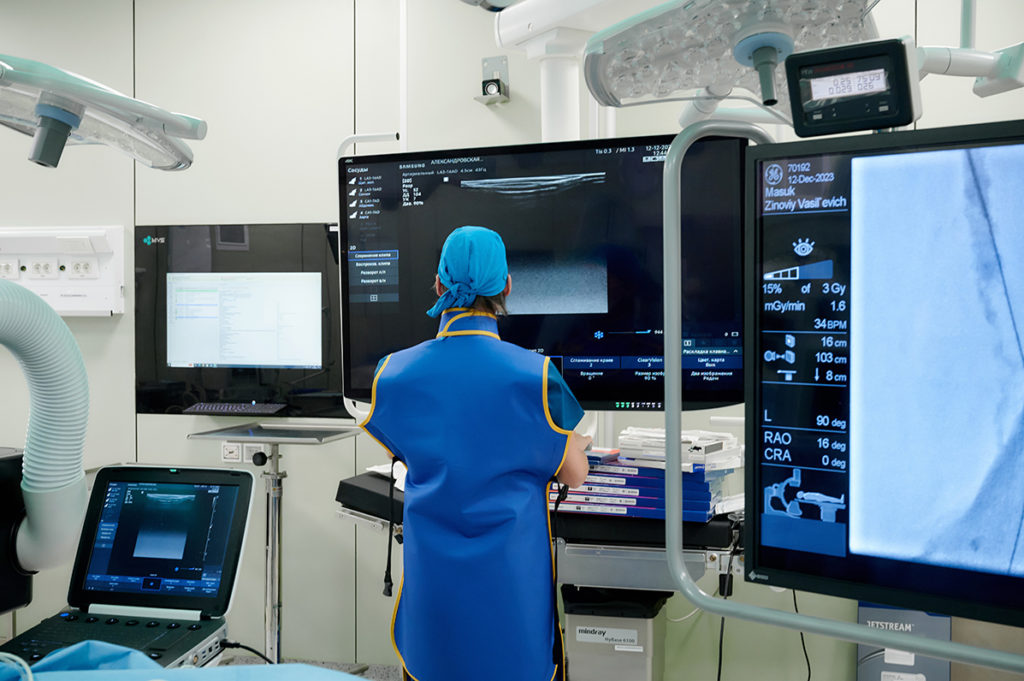
— What diseases are treated in the RVC at the department of vascular Surgery?
— V. Z.: The basis is a rapid flow, emergency care is provided for heart attacks and strokes, because the rule of the “therapeutic window”* applies to patients with acute cerebrovascular accident and acute myocardial infarction. In our vascular department, this is mainly planned care, including high-tech care – according to quotas.
We take patients with atherosclerotic lesions of the brachiocephalic arteries – these are patients who have suffered a stroke, and we operate on them so that there is no repeat stroke with atherosclerotic lesions of the internal carotid artery. Despite the fact that the first operation in the new operating room was performed only in March 2023, according to preliminary estimates, we operated on more than 200 patients with brachiocephalic vascular lesions over the year and, frankly, these figures are frightening.
The next area of our department is interventions on the aorta and its branches — aneurysmal (abdominal aortic aneurysm) or atherosclerotic aortic lesion with blockage or significant stenosis. We perform endovascular, open, hybrid operations. Such interventions are carried out according to quotas, which are distributed at the beginning of the year. Last year we just started work, there were few quotas, but considering the statistics, for 2024 we applied for a large number of quota operations.
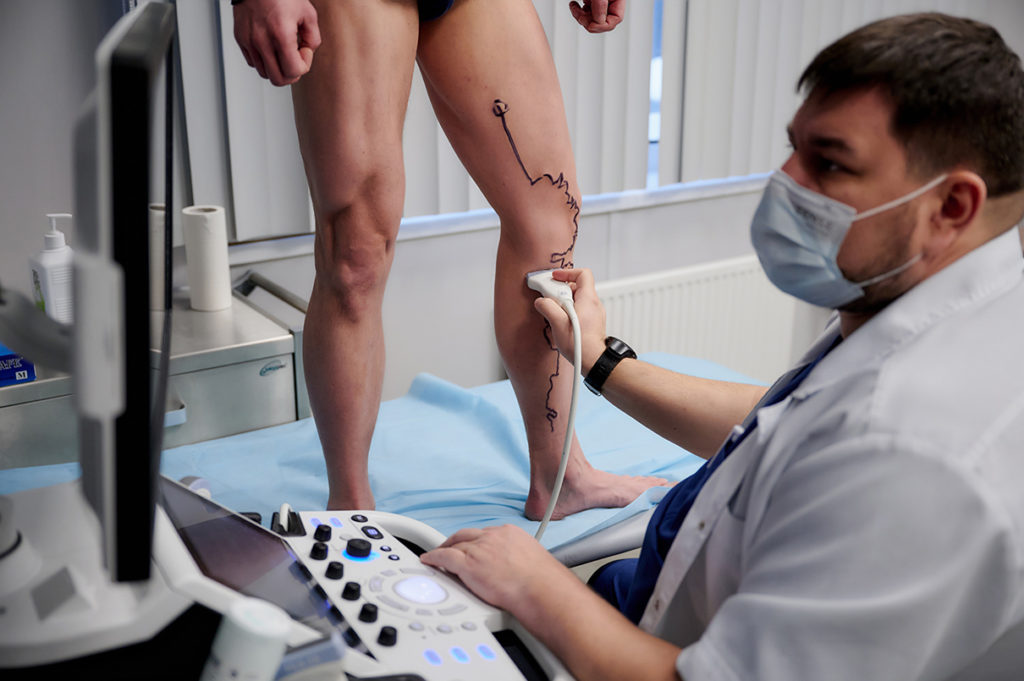
— What other vascular diseases do you deal with?
— V. Z.: It is impossible not to mention the socially important stratum of patients with vascular lesions of the lower extremities (peripheral artery diseases), which in the terminal stage of the disease lead to ischemia of the lower extremities, threatening limb loss — amputation.
Unfortunately, world statistics show that mortality from lesions of the arteries of the lower extremities with the threat of amputation is ahead of many oncological diseases.
Of course, much attention is paid to the treatment of patients with venous pathology, most of whom are women with varicose veins of the lower extremities.
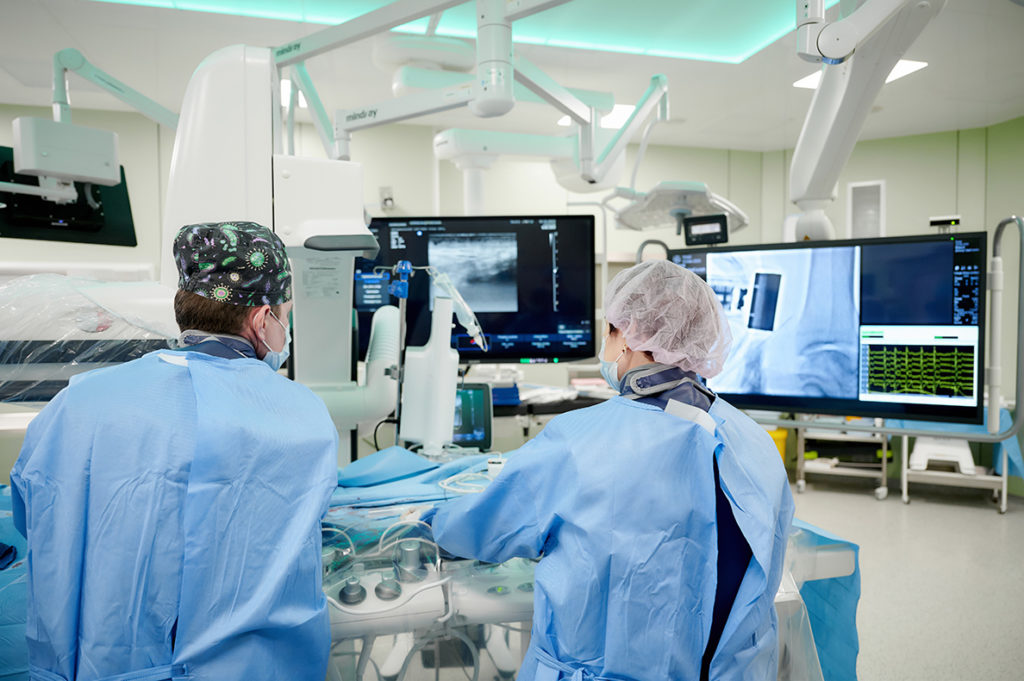
Varicose veins are not just a cosmetic problem, but also a severe venous hemodynamic pathology, which in some cases can be complicated by venous thrombosis, thromboembolic complications and the formation of chronic venous ulcers of the extremities, which pose a threat to the patient’s life.
The department has the capabilities of both traditional surgery of varicose veins and modern endovenous minimally invasive method of obliteration of pathological veins using laser installations, one of which is a “third generation” laser. We also deal with endovascular treatment of thrombosis and postthrombotic changes in the human venous system.
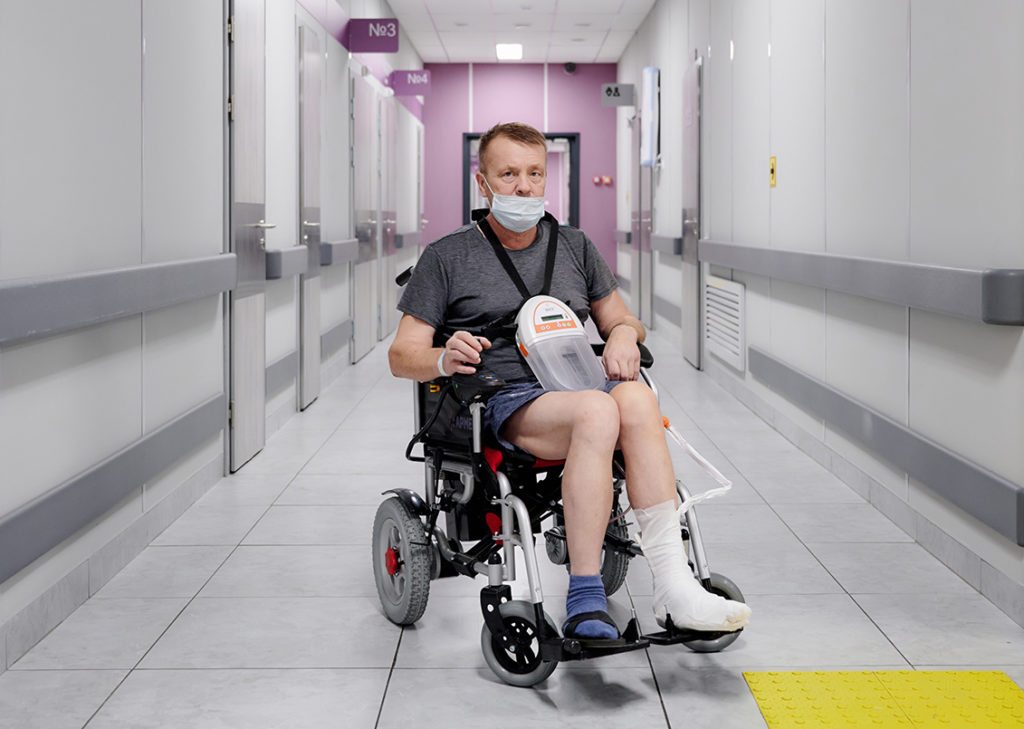
— Tell us more about it.
— V. Z.: Patients with peripheral artery disease are one of the most important areas of treatment in our department.
The specificity is that in real life, the patient does not come complaining about a blockage of a particular artery. He complains of pain in his leg at rest, or blackening of a finger or part of the foot, the formation of ulcers — these are all manifestations of damage to the arteries of the lower extremities. For such patients in St. Petersburg there is a unique compulsory medical insurance rate, which is not available anywhere else in Russia. It allows us to perform any open vascular endovascular intervention (balloon angioplasty, stenting, mechanical thrombectomy and atherectomy).
As part of this tariff, this year we plan to introduce medicinal technologies — special stents or cylinders with medicines, as well as debalking technologies — removal/drilling of a blood clot or atherosclerotic plaque inside a vessel with special devices. It is very important that in addition to open, endovascular and hybrid operations, the tariff also allows you to cure an ulcer, gangrene and save a leg (including the possibility of hydrosurgical necrectomy, negative pressure therapy of a postoperative wound), and then perform plastic reconstructions. Eventually, people walk away on their own feet. It is important that we provide all this assistance in our department, do not transfer the patient to another hospital.
— A huge number of people face vascular diseases of the lower extremities.
— V. Z.: Yes, therefore, for the first time in the city, and possibly in the country, we plan to organize assistance to patients with lower limb artery disease at earlier stages.
We plan to organize the first Treatment Center for intermittent claudication, when surgery is not needed yet, but the help of a doctor is already required: therapeutic training walking, correction of risk factors, smoking cessation, correction of lipid profile disorders, blood clotting, possibly gene methods of angiogenesis. At the moment, these patients are deprived of the attention of specialists and can rarely get help in “one place”. It’s like I came to the MFC and did everything at once.
We are also thinking about creating the city’s first Center for the treatment of trophic disorders in vascular diseases (diabetic foot syndrome, venous trophic ulcers, arterial ulcers and necrosis, ulcerative lesions in other vascular diseases and pathologies). But for this, we need the help of not only the hospital management, which supports our initiatives. We count on the support of the entire community of specialists, the leadership of the Health Committee, the city administration, the governor, and sponsors.
We are also thinking about the implementation in St. Petersburg of a pilot project to help patients with thrombosis and pulmonary embolism with the introduction of modern endovascular methods of treatment of these patients in order to reduce mortality in this severe category of patients. As you can see, there are a lot of plans.
— Are the patients of your department mostly residents of St. Petersburg?
— V. Z.: First of all, residents of the Nevsky, Krasnogvardeisky, and Kalininsky districts of the city come to the center, but there are no territorial restrictions. We accept everyone regardless of their place of residence, we have many patients from other regions.
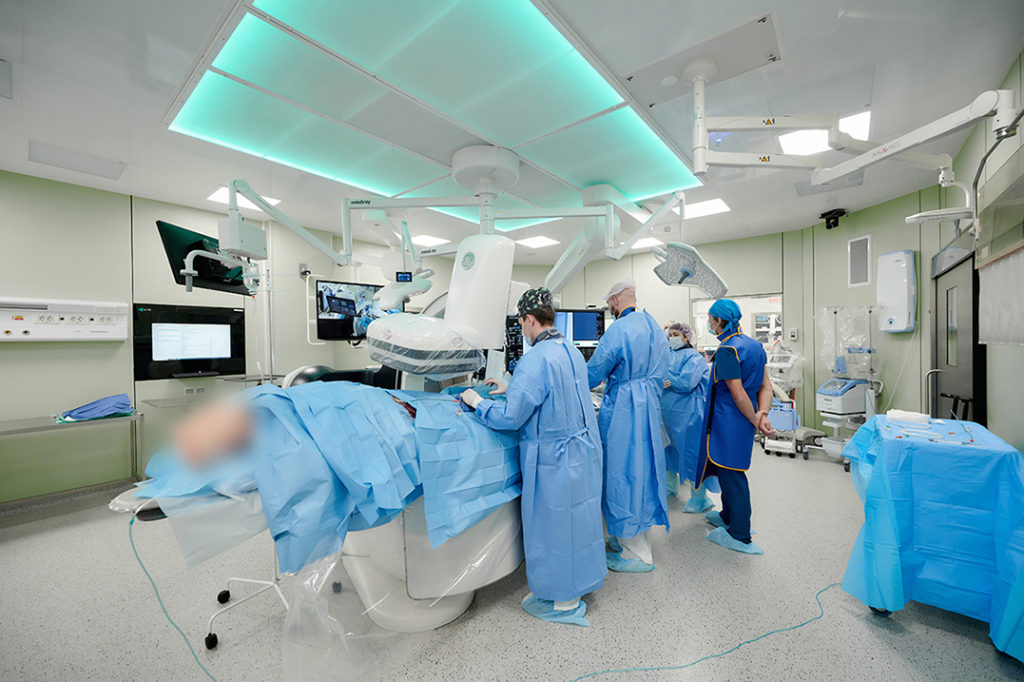
View from the screen
— When talking about the hybrid operating room, you mentioned the video recording of operations. How is it organized and why is it necessary?
— V. Z.: Yes, there is video recording of operations in our operating rooms. This is one of the functions of the MVS Integrated Operating Room. This is not just a stationary video camera. The recording from it, of course, is not enough to analyze the operation in detail later. We record video from all video sources connected in the operating room: surveillance cameras, X-ray, ultrasound, microscope, camera of the surgical lamp directly above the operating table, patient monitor. To be honest, I don’t understand how you can work without it anymore.
In my opinion, this has some advantages for both patients and doctors. First of all, this video evidence is protection for a doctor. It is a tool for training other doctors and analyzing operations. But there is another important aspect — the history of surgical interventions. For example, if we are talking about atherosclerosis, there is currently no cure for it. Often, the case is not limited to one surgical intervention, they are repeated. And here the problem arises – where can the surgeon see what happened to the patient before?

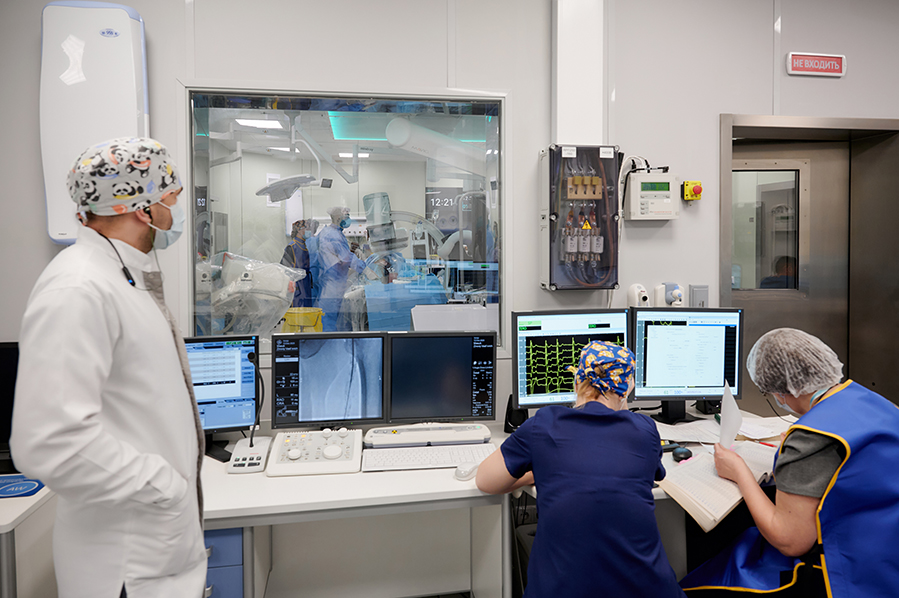
— So, as a surgeon, you need a video history of the patient’s operations?
— V.Z.: That would be ideal. A simple example is that we have many patients who have already been operated on in other hospitals. And in this case, we were unable to restore the patency of the artery, because, most likely, it was bandaged in the last hospital. Moreover, I am in favor of making video recordings of operations available to all interested doctors, so that there is continuity of surgical interventions, like a medical history.
The future belongs not only to e-health, but also to a single video archive of surgical interventions. Now all hospitals in the country are scattered, it is often impossible to restore the course of treatment, and the most difficult surgical interventions, as you know, are repeated.
I often tell my patients: “Go to the hospital where you had a previous operation, take the protocol (not the discharge epicrisis, but the protocol).” A discharge epicrisis is not always enough for proper planning of a repeat operation. We need to know all the details, for example, what kind of prosthesis, how it is sewn, how it is carried out in tissues, what patches are made, with the formation of a fistula, without a fistula, whether an artery has been ligated. After all, all this affects the choice of subsequent tactics and the success of a repeat operation, because each subsequent operation is more difficult than the primary one. Therefore, I consider “smart operating rooms” with video recording to be a new stage in surgery, I think that in the future we will come to a single database of surgical interventions within the country with the possibility, if necessary, of access for the patient and doctors.
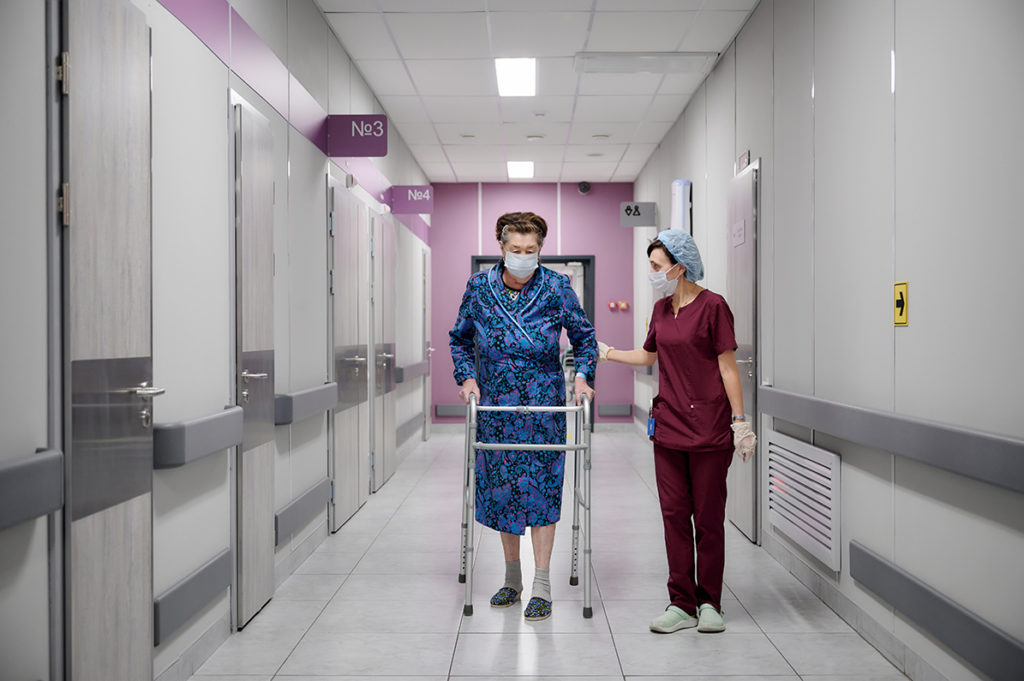
— From the patient’s point of view, apart from security control, what else is different about your operating rooms?
— V. Z.: Safety is a key point, but do not forget that many operations are performed under local anesthesia and patients are conscious, so their psychological well—being is very important to us.
With the help of the MVS system, we can adjust the lighting color during surgery at the patient’s request — pink, green, any RGB shades. Since operations are often performed under ultrasound control, the illumination in the operating room is important for surgeons, which now changes from any MVS control monitor.
Thanks to the capabilities of the MVS Smart Operating Room, we set music for the patient during the operation. Someone asks for classical music, someone for rock, or we can display a music video on the MVS system screen. Recently, a young patient wanted to watch Olga Buzova (russian pop-singer) during surgery, and we put a selection of clips on the monitors. It seems that these are excesses, but believe me, the psycho-emotional state of patients greatly affects the outcome of the operation.
— Tell us more about the specialists working at the vascular surgery department. How did you select a team?
— V. Z.: It should be noted that the prerequisites for the opening of the department of vascular surgery and neurosurgery within the framework of the RVC at the Alexander Hospital were long ago. Vascular beds were deployed in the Department of General Surgery, there were also neurosurgery departments with highly qualified neurosurgeons, there were vascular specialists who mainly treated venous pathology, varicose veins, acute thrombosis, carotid artery pathology.
The old-timers, of course, were offered to work in the new york Times, Konstantin Chernykh and Nikolai Yakovlev became the first honorary employees of the Department of Vascular Surgery. The rest of the surgeons were carefully selected by me and the Deputy Chief of Surgery on a competitive basis. I would like to note that many specialists wanted to work in the new RVC — professionals are attracted by cutting-edge conditions with a unique vascular hybrid operating room, so there was a competition, and we selected the best doctors.
The doctor Andrey Pletnev moved to us from Volgograd, another specialist Nikolai Susanin moved from Almazov Scientific Medical Research Center. There is also a doctor from the Elizavetinskaya Hospital, Alexander Ulko. Oleg Kudryavtsev, PhD, is an endovascular surgeon on staff.
The most important requirements for hiring in our department are the availability of three certificates — in vascular surgery, X–ray endovascular surgery and ultrasound diagnostics. Because at this stage of the development of vascular surgery, a specialist without these competencies, let’s say, is inferior – let no one take offense at me, but this is a fact.
The ultrasound sensor is an “extension of the arm” of the vascular surgeon, as well as the introducer is an “extension of the second arm”.
— In addition to professional qualities, are the personal qualities of doctors important to you when applying for a job?
— V. Z.: Of course. And the first thing I pay attention to is the kind and professional attitude towards the patient. By the way, we do not miss a single birthday of the patient, we come to congratulate the whole team in the ward with gifts and flowers.
Teamwork and scientific work, communication with colleagues, and mutual assistance are also of great importance. During the first year of work, I and the staff of the department presented reports, presentations and speeches at twelve medical congresses, conferences, including at the international level, six master classes were held in St. Petersburg and other Russian cities.
We like to gather the whole staff of the department for the new year, the day of the medical worker, celebrate common achievements. This is important for us.
— Why did you choose vascular surgery?
— V. Z.: Like most graduates of the Faculty of the Navy of the Military Medical Academy named after S. M. Kirov, I became a general surgeon and served as a surgeon, head of the medical service of the ship of the Baltic Fleet.
During my residency in surgery, I decided to get a narrow specialization of an oncologist surgeon, but after meeting my future teachers, outstanding vascular surgeons, Professor Yuri Stoiko and Professor Vladimir Soroka, I decided to become a vascular surgeon, which I never regretted in later life.

* The principle of the “therapeutic window” implies that in the initial life-threatening conditions at the very beginning of the disease, there is a time interval when the cells and/or tissues of the body affected by the lack of blood flow suffered insignificantly and regression of the disease is possible with the restoration of blood flow. If you do not meet this time period, the consequences may be irreversible.



